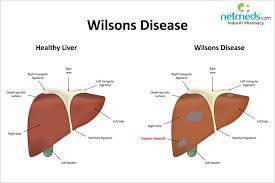Wilson's disease is a rare genetic disorder that affects copper metabolism in the body. Here are 20 causes, signs and symptoms, effects, and solutions related to Wilson's disease:
**Causes:**
1. Genetic mutations in the ATP7B gene.
2. Autosomal recessive inheritance.
3. Both parents carrying a single gene mutation.
4. Family history of Wilson's disease.
5. High prevalence in certain populations (e.g., Eastern European Jews).
6. Consanguineous marriages (marriages between close relatives).
7. De novo mutations (rare cases).
8. Mutations leading to defective copper transport in the liver.
9. Altered ATP7B protein function.
10. Unknown genetic mutations in some cases.
11. Interactions with other genetic factors.
12. Mutations affecting copper binding in the liver.
13. Mutations affecting copper excretion.
14. Altered regulation of ceruloplasmin (a copper-binding protein).
15. Mutations leading to copper buildup in liver cells.
16. Copper-rich diet.
17. Exposure to environmental copper (rare).
18. Long-term oral contraceptives use (may exacerbate copper buildup).
19. Pregnancy (may increase copper accumulation).
20. Hormonal changes during puberty.
**Signs and Symptoms:**
1. Fatigue and weakness.
2. Jaundice (yellowing of the skin and eyes).
3. Abdominal pain and discomfort.
4. Enlargement of the liver and spleen.
5. Cognitive and psychological changes.
6. Kayser-Fleischer rings (copper deposits in the corneas).
7. Neurological symptoms (tremors, dystonia, dysarthria).
8. Behavioral changes.
9. Psychiatric symptoms (depression, psychosis).
10. Changes in personality.
11. Speech difficulties.
12. Dysphagia (difficulty swallowing).
13. Lack of coordination.
14. Liver problems (hepatomegaly).
15. Hemolysis (destruction of red blood cells).
16. Anemia.
17. Renal disturbances.
18. Osteoporosis and bone problems.
19. Skin changes (e.g., skin rashes).
20. Gastrointestinal disturbances (e.g., vomiting).
**Effects:**
1. Copper buildup in the liver.
2. Liver damage and cirrhosis.
3. Impairment of liver function.
4. Copper accumulation in other organs (e.g., brain, kidney).
5. Neurological and psychiatric issues.
6. Hepatic encephalopathy.
7. Kidney damage.
8. Hemolytic anemia.
9. Bone and joint problems.
10. Changes in bone density.
11. Gastrointestinal disturbances.
12. Impaired speech and coordination.
13. Behavioral and mood changes.
14. Cognitive impairment.
15. Psychosis and delirium.
16. Impairment of quality of life.
17. Increased risk of accidents and injuries.
18. Renal dysfunction.
19. Increased risk of kidney stones.
20. Risk of copper toxicity-related complications.
**Solutions:**
1. Genetic testing and counseling for at-risk individuals.
2. Medications to lower copper levels (e.g., D-penicillamine, trientine).
3. Zinc supplements to block copper absorption.
4. Liver transplantation in severe cases.
5. Regular medical monitoring and follow-up.
6. Diet low in copper-rich foods (e.g., liver, shellfish).
7. Avoiding dietary copper supplements.
8. Management of symptoms and complications.
9. Supportive care for liver disease.
10. Support from healthcare professionals.
11. Psychological support and counseling.
12. Support from family and friends.
13. Nutritional counseling.
14. Managing neurological and psychiatric symptoms.
15. Monitoring and managing bone health.
16. Medications to treat psychiatric symptoms.
17. Regular ophthalmologic assessments.
18. Support groups for Wilson's disease patients.
19. Public health initiatives to promote awareness.
20. Educational programs for healthcare professionals.
Management of Wilson's disease typically involves lifelong treatment and regular medical monitoring to ensure that copper levels are kept under control and that complications are managed effectively. If you suspect you have Wilson's disease or are at risk, consult a healthcare professional for evaluation and guidance.


